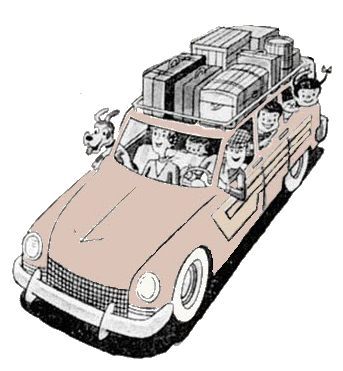
Recent surveys, including one by NeighborSpace last fall, have put safe places to walk at the top of the list of recreational amenities important to County residents. This is not surprising, given the pervasively low walk scores that exist in the County. And the pandemic has done nothing but exacerbate this demand: 650,000 people used the Northern Central Railroad Trail near Monkton between January and June of last year, three times the prior year's number. The complaints about people parking illegally to use that same trail surfaced in a County Council meeting last year, leading to a heated exchange about the fairness of the rules under consideration to curb the violations.
But it is the fact that you have to get in your car at all to take a nice walk that I want to discuss here. The lack of publicly accessible, networked open space for walking and recreation is a big problem and we are no closer to addressing it meaningfully in Baltimore County today than we were when I started this job, now over 11 years ago. In this article, I want to (1) discuss what we mean by publicly accessible, networked open space, (2) reiterate the magnitude and inherent unfairness of our open space challenges, (3) outline their ramifications for livability, (4) speak to why they are so intractable, and finally (5) ask you to become advocates for addressing them.
(1) What Is Publicly Accessible, Networked Open Space?
These are interconnected open space hubs (e.g., parks, athletic fields) and connecting corridors (e.g., trails, greenways, pathways), sometimes called a "green network," that are accessible from home. This is not a new idea and we only have to look as far as the City of Baltimore for a 117 year-old example: The 1904 Report Upon the Development of Public Grounds for Greater Baltimore. This report, written by the sons of famed landscape architect, Frederick Law Olmsted, laid out a system of open spaces and developed areas throughout the city - parks, churchyards, public squares, playgrounds, school campuses, and schoolyards - linked by tree-lined parkways, boulevards, stream valleys, and pathways. It remains a guide for balancing open space and development of real estate in the City today.
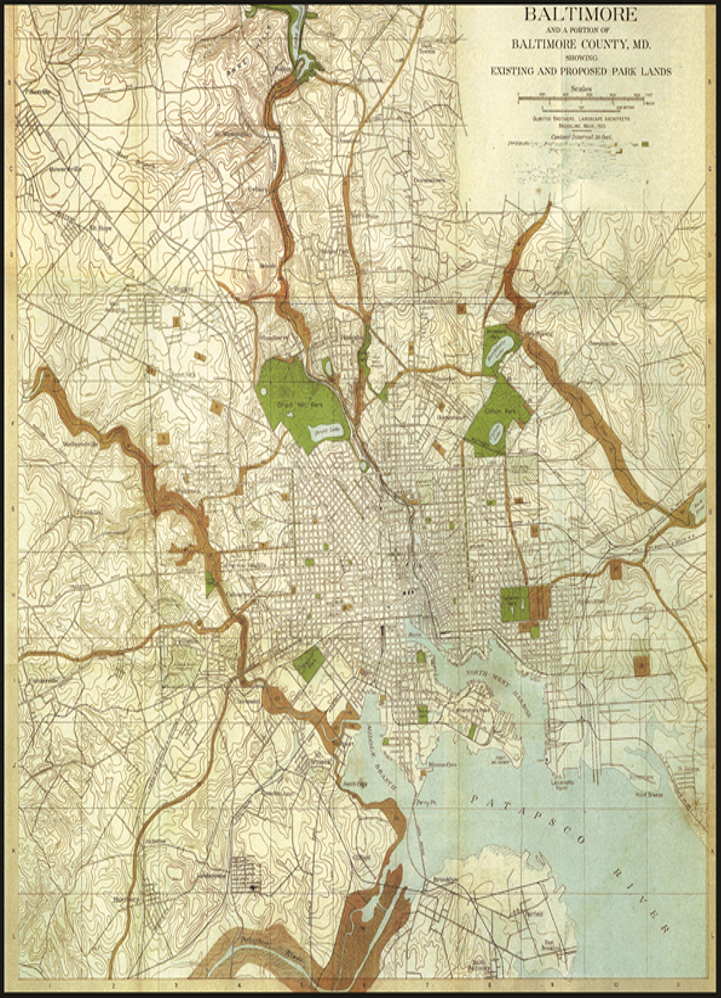
Another example, on a smaller scale, is the Bear Creek Heritage Trail, a project on which NeighborSpace is working with members of the Dundalk community. As the map indicates, the trail project would link, connect, and reinvigorate existing parks, trails and school properties along the entirety of its 1.25 mile length.
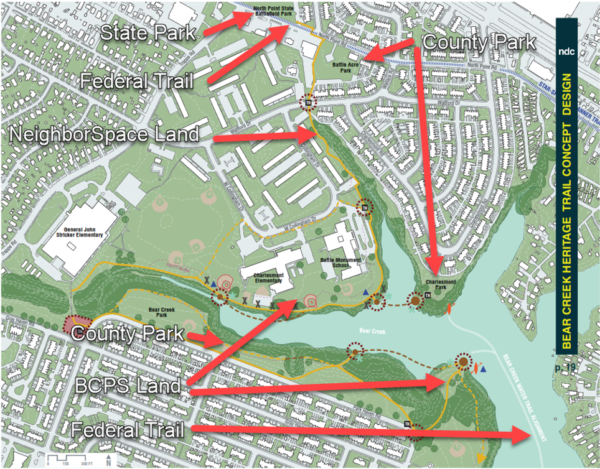
On an even smaller scale is this plan, shared with me a couple of years ago by Delegate Cathi Forbes, for a system of proposed trails connecting neighborhoods in Rogers Forge, various athletic fields, and two public schools. This is a relatively inexpensive project and what an amenity it would be for the densely populated surrounding neighborhoods!
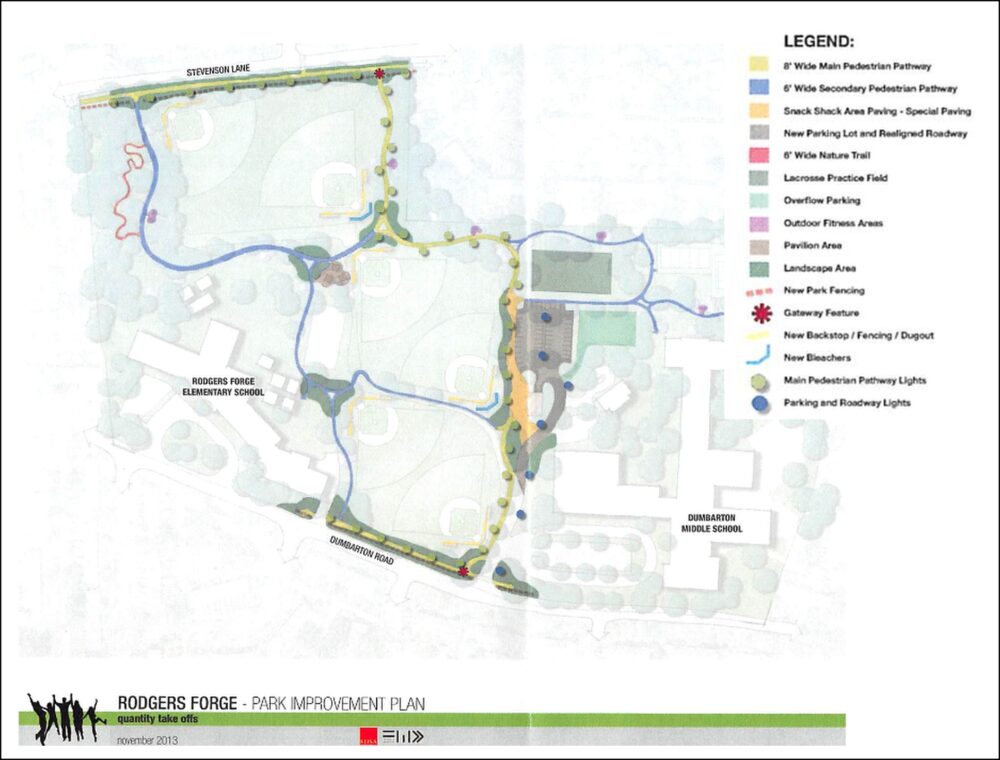
(2) The Magnitude and Inherent Unfairness of Our Open Space Deficit
The sad truth is that none of the County examples I showed you above are built, a symptom of our chronic open space challenges. By now, you are sick to death of my harping on the fact that 65 percent of residents inside the URDL lack access to adequate open space within a quarter mile of home. How does NeighborSpace know this? An expert actually measured it in a geographic information system, a kind of digital map. What is "adequate open space?" It's a useable area of at least 1,000 square feet, as spelled out in the county's adequate public facilities law on open space. Why is a quarter mile important? It's an accepted distance that someone will walk before deciding to jump in a car and drive instead. What's unfair about it? Just look at the map. The deficit is worse on the east and west sides of the county, places where there are higher concentrations of vulnerable populations, people, who, by definition, typically cannot get into their cars and drive to a park.

(3) The Ramifications for Livability
The lack of an accessible green network has a negative impact on livability, i.e., our quality of life. I'll touch on a few of these impacts here.
(a) Social Impacts: Health
The lack of accessible green spaces and trails contributes to low walkability and low levels of physical activity - few of the 16 inner suburbs inside the URDL are considered even "somewhat walkable" (see the yellow markers in the map) and most are "car-dependent." Low walkability and low levels of physical activity, are, in turn, linked to poor health outcomes: Addressing the impacts of obesity is among 4 current health improvement priorities for the Baltimore County Health Department.
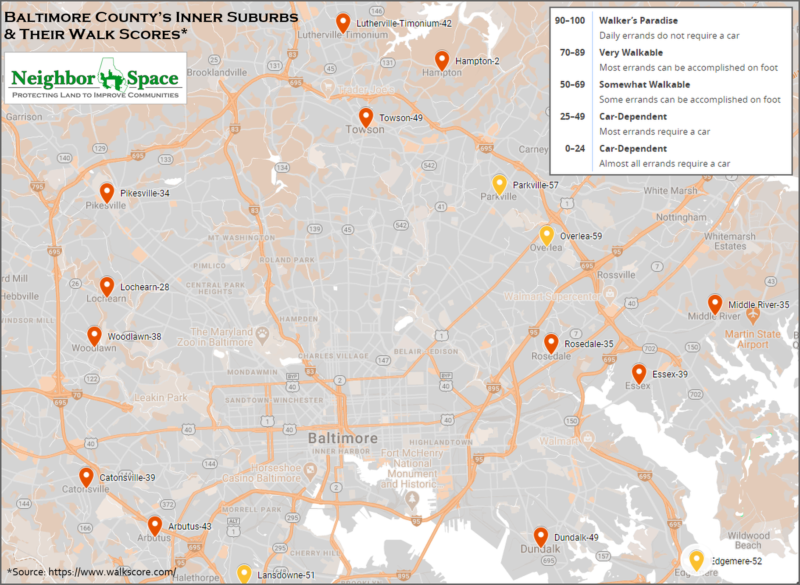
(b) Economic Impacts: Home Values
The housing stock in the county is among the oldest in metropolitan Baltimore, a result that contributes to low home values and community instability. More investment in this housing stock is necessary if the County is to compete with surrounding jurisdictions for new residents. The reality, however, is that such investment will need a catalyst that drives people to want to live in an older community: the presence of amenities like accessible green spaces and trails.
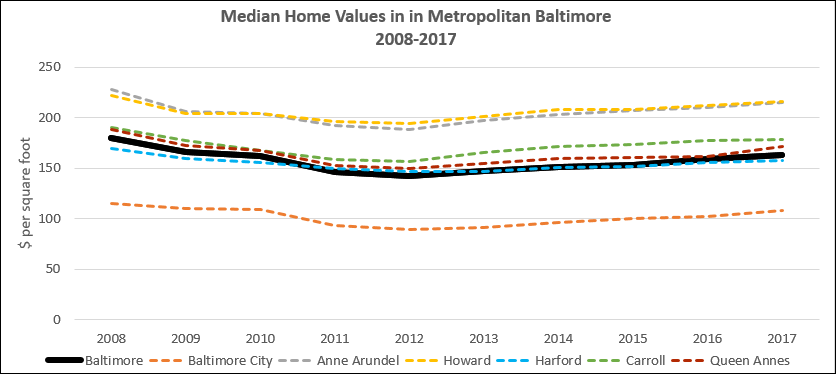
(c) Environmental Impacts: Water Quality
Few of us have escaped the challenges of flooding in our neighborhoods, a result of our rapidly changing climate. In addition to being inconvenient, untreated stormwater is wreaking havoc on water quality in our streams and the Bay. Nearly every pocket park NeighborSpace builds contains green infrastructure to help manage and treat neighborhood stormwater in an aesthetically pleasing way, using practices such as rain gardens and vegetated swales. Doing a lot more of this is important given that nearly every watershed inside the URDL is impaired by sediment and/or nutrients.
(4) The Intractability of Our Open Space Challenges
Among the root causes of our lack of publicly accessible, networked open space are (a) the County's failure to plan, (b) a lack of funding, (c) the County's failure to enforce the law, and (d) a challenged open space ordinance. I'll review each of these briefly, in turn.
(a) A Failure to Plan
Unlike many other nearby jurisdictions, Baltimore County has no green infrastructure plan. In Baltimore City, there is the "Green Network Plan," designed to connect the City's existing parks, water bodies, and natural areas with paths for walkers, joggers and bicyclists. Its ultimate goals are (1) providing better access to park amenities and (2) creating a new recreational and non-vehicular transportation network. Examples of other local jurisdictions with similar plans include both Howard and Harford counties.
(b) A Lack of Funding to Acquire Land
Examine the County Capital budget for FY 2022 and you will find that, while there is a laudable increase in funding for parks, preservation and greenways owing to a recent, large bond referendum, only about 5% of the total $42.475 million budget is earmarked for land acquisition by the County. (This is not a criticism of the Department of Recreation and Parks, by any means. It has a backlog of needs that would choke a horse).
And there is little hope that any slack in County funding for acquisition of land for pocket parks and trails will be picked up by NeighborSpace. The $150,000 coming to the organization is just an estimate based on what the County collects in open space waiver fees annually. Last year the County collected $92,500 and NeighborSpace received $18,500, a statutory 20 percent share. In a survey conducted by NeighborSpace last fall, 33 respondents proposed new pocket park sites in their neighborhoods. $18,500 doesn't come close to the cost of acquiring and/or improving even one of those sites. What's more, it won't allow us to stay in business very long.
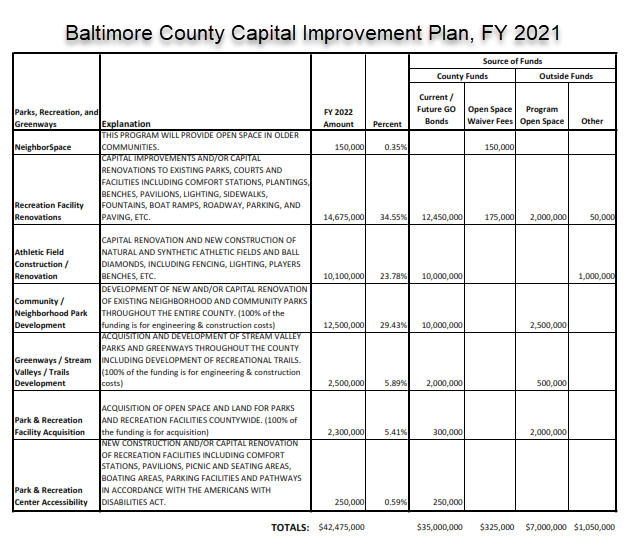
(c) A Failure to Enforce Existing Law
County law requires developers of residential subdivisions to provide 1,000 square of open space per dwelling unit. That law is in a section of the County Code entitled "Adequate Public Facilities." The theory behind such ordinances is to ensure that there are adequate levels of open space to serve both new and existing residents, i.e., that growth mitigates and does not exacerbate an existing need for public open space, that there is balance. Here, I'll outline the areas where enforcement of this law is lax, at best.
(i) No Mitigation
In researching all new development projects for which there were records going back to November 1, 2016, NeighborSpace found that roughly 2/3 of them were in areas of the County where there is a high social need for open space, i.e., an existing deficit of open space and the presence of multi-family housing and/or vulnerable populations. Given this fact, and the legal requirement to mitigate impacts on existing residents, you would expect to see a lot of new public parks in connection with these projects. Unfortunately, that's not what the research revealed. Of the 9 projects that provided any open space at all, just one of them created a park open to both new and existing residents. The County allowed the balance of projects to create private open space on private land, further exacerbating the open space deficit in high social need communities.
(ii) No Fee Schedule
Another place where the County has failed to enforce the law is in establishing the fees themselves. The ordinance contains a tiered structure in which fees rise with density and requires that the fees cover both the cost of land acquisition and improvement. The Administration is required to review the fees every two years. Since November 1, 2016, when this new tier system became the law, the Administration has never submitted the required schedule of fees to the Council for approval. Last fall, NeighborSpace participated on a County Committee established to provide recommendations about the fee schedule. As of this writing, however, no bill to advance a new schedule has been forthcoming.
(iii) No Feasibility Showing
Yet another area of failed enforcement has to do with the law's requirement that a developer demonstrate that is not feasible to provide open space on or off of a development site before being allowed to pay a waiver fee. I've been called to testify as an expert in two cases involving this issue, which means I extensively reviewed the case records in preparation for those hearings. Given the pressing need for open space and the mandate in our law, you would expect the County to require a developer to make some effort to identify off-site open space (e.g., call NeighborSpace) when it is not possible to meet the open space requirement on site. In neither case was any effort to do so required by the County or demonstrated by the developer. Developers, instead, went straight to paying a fee and to using a loophole in County law, discussed below, to avoid making any cash payment to the County.
(d) A Challenged Ordinance
The open space waiver fee ordinance has many challenges, the result of years of legislative sausage-making. I will outline two important elements that are ripe for change.
(i) A Questionable Standard
When you dig into it, you find there is really no rhyme or reason for the requirement that a developer provide 1,000 square feet of open space per dwelling unit. My research into similar laws from other jurisdictions revealed that the established requirement is typically based on an existing level of service, i.e., a neighborhood's existing acreage for community parks. This is a predictable, verifiable, and reasonable number versus what we have, which appears to have been pulled from a hat. Maybe if we used real, common-sense numbers to establish our open space standards, there would be less monkeyshines on the part of developers and their attorneys when it comes to compliance and fewer attempts at legislative sausage-making? (Wishful thinking, perhaps).
(ii) A Giant Loophole
Another provision allows developers to reduce the open space waiver fee they pay by 100% of the verified cost of any public amenities provided on or off site. In one project I reviewed, the developer proposed to avoid paying open space fees by using this loophole to provide $340,000 in amenities to two neighborhoods across the street from the development project, places that are not in high social need areas. (Do you think these folks spoke in opposition to the project at the Community Input Meeting?)
The amenities included things like shade structures, picnic tables, grills, exercise equipment, vinyl fencing and sidewalks, all fairly innocuous until you start to think about the 65 percent of residences inside the URDL that lack adequate access to open space within a quarter mile of home. The $340,000 is more money than the County collected annually in open space waiver fees in five of the last 10 years. Just think what the Department of Recreation and Parks and NeighborSpace could have done with those funds in areas where there are high open space deficits and concentrations of multi-family housing and vulnerable populations!
(5) Advocating for Change
There are plenty of first suburbs around the country with postwar development patterns similar to our own that have made great strides in providing publicly accessible, networked open space for their citizens. The Fox River Valley in the first suburbs of Chicago, for example, has a wealth of public bicycle trails, providing many opportunities for riders to take in the beauty of nearby state parks, landmarks, and nature preserve areas. Another example is Buckhead, Georgia in the first suburbs of Atlanta, where the nonprofit, Livable Buckhead, is creating an interconnected network of parks, trails and green spaces serving the needs of Buckhead’s residents, workers and visitors. If they can do it, so can we.
That's why I'm asking that you make your voice known in connection with the upcoming virtual budget Town Halls and advocate for open space. The 4th district hearing has already happened, but the remaining Town Hall Meetings are as follows:
- 5th District: Tuesday, February 23, 6:30 PM
- 6th District: Tuesday, March 2, 6:30 PM
- 2nd District: Monday, March 8, 6:30 PM
- 1st District: Thursday, March 11, 6:30 PM
- 7th District: Tuesday, March 16, 6:00 PM
- 3rd District: Thursday, March 18, 6:30 PM
If you are uncertain about your district, you can find it here. Information on listening to / viewing the Town Halls is available here.
What I am hoping you will do specifically is this: Send an email in advance of the date for your district's meeting asking the County Executive to (1) fix the enforcement of and challenges with the open space law, and to (2) provide an additional appropriation for the acquisition of open space and trails in the budget. The email should be sent to townhall@baltimorecountymd.gov. NeighborSpace has created this template that you can use to draft your email.
Thank you for the privilege of your time and attention and for your help with this important issue!
I’m 84 years old and have lived in Catonsville for over 60 years. I currently live in a condo development. I have to drive everywhere. Unfortunately, I didn’t consider this when I bought 10 years ago. I still drive but at some point I will decide not to. I’d love a nice apartment within walking distance of amenities like a library, market,c offee shop, etc. Whenever there’s a multi-family plan proposed by a developer the hue and cry is raised by younger residents who only want sports fields. I’m now looking for a place out of Maryland where those things and dependable public transportation are possible. Thank you for your efforts. I’ll contact the county prior to the hearing for my area. Thank you for fighting for sustainability and walkability.
Dear Marlene:
Thank you for your thoughtful note and for taking the time to write. I’m a little slow in responding owing to my mother passing away earlier this week. I tell you this because she lived in Mays Chapel with my father, who I am spending time with right now. They moved here from out-of-state, wanting to be closer to my two sisters and me. When I looked for a place in Baltimore County where there were nice condominiums within walking distance of a grocery store and other amenities, the choices were minimal. You still need a car here, for sure, but you can walk to a grocery store, a drug store, and a couple of restaurants. There are also a number of health care facilities within walking distance. In addition, there are beautiful walking trails (even if the stormwater management practices that border them are substandard, typical of what our County government has, sadly, permitted over time). On the downside, public transportation is lacking and the accommodations definitely don’t fall in the affordable category. In a county with one of the highest percentages of residents 65+ in the State, that’s a real problem and one of the reasons that we’ll keep fighting for walkable, sustainable communities.
My deepest sympathy on the loss of your mother.
Thank you for responding at such a sad time.